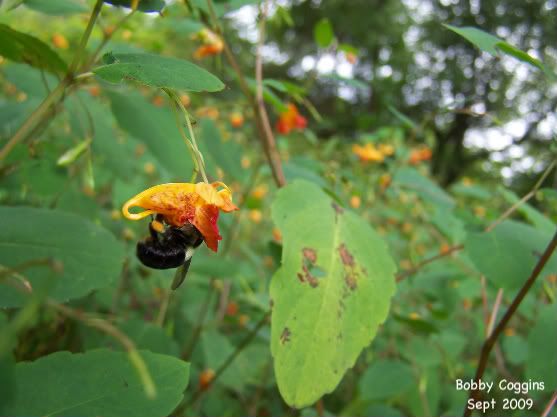
I've been enjoying watching the bees and other insects pollinate the Orange Jewelweed in my backyard, but have been unable to catch a glimpse of the hummingbirds doing the same. I've seen them fly way upon my approach, but these birds are so much more skittish than even Cardinals, that I despair of ever capturing them for the camera unless I set up feeders specifically for them. I grew up knowing the flowers under the name of Touch-me-not because of the way the ripe seedpods (they resemble the seedpods of green beans, but much smaller) burst open when you touch them. I'll try to capture that at a later time.
Impatiens capensis, the Orange Jewelweed, Common Jewelweed, Spotted Jewelweed or Orange Balsam, is an annual plant native to North America. It is common in bottomland soils, ditches, and along creeks, often growing side-by-side with its less common relative, Yellow Jewelweed (I. pallida).
The flowers are orange with a three-lobed corolla; one of the calyx lobes is colored similarly to the corolla and forms a hooked conical spur at the back of the flower. The stems are somewhat translucent, succulent and have swollen or darkened nodes. The seed pods are pendant and have projectile seeds that explode out of the pods when they are lightly touched, if ripe, which is where the name touch-me-not comes from. Along with other species of jewelweed it is a traditional remedy for skin rashes, although controlled studies have not shown efficacy for this purpose.
The species name "capensis", meaning "of the cape", is actually a misnomer, as Nicolaas Meerburgh was under the mistaken impression that it was native to the Cape of Good Hope, in southern Africa [1]
Impatiens capensis was transported in the 19th and 20th by humans to England, France, the Netherlands, Poland, Sweden, Finland, and potentially other areas of Northern and Central Europe. These naturalized populations persist in the absence of any common cultivation by people. This jewelweed species is quite similar to Impatiens noli-tangere, an Impatiens species native to Europe and Asia, as well as the other North American Impatiens. No evidence exists of natural hybrids, although the habitats occupied by the two species are very similar.
Next is a video and photos I put together in a montage of Hummingbirds at my grandparents home in Jackson County:






























0 comments :
Post a Comment